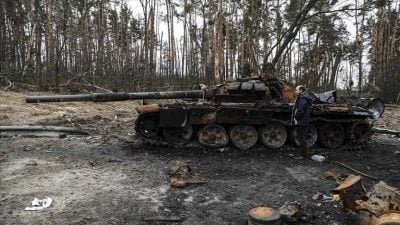Western-supplied Weapons “All Burned” in Ukrainian Failed Counteroffensive – NYT

All Global Research articles can be read in 51 languages by activating the Translate Website button below the author’s name.
To receive Global Research’s Daily Newsletter (selected articles), click here.
Click the share button above to email/forward this article to your friends and colleagues. Follow us on Instagram and Twitter and subscribe to our Telegram Channel. Feel free to repost and share widely Global Research articles.
***
More and more evidence show the absolute failure of the “Ukrainian counteroffensive”. According to a major Western media outlet, around 20% of Kiev’s [NATO-supplied] weapons were destroyed by the Russian armed forces during the first two weeks of the Ukrainian counterattack. Sources believe that this military disaster led the Ukrainian authorities to “pause” the operation, given the high casualty rate.
The information was published on July 15 by the New York Times. The article considers the beginning of the counteroffensive to be the first half of June, when the Ukrainian armed forces launched frontline raids from Kherson to Donetsk. Unnamed American and European officials told the NYT that in the first two weeks the moves resulted in the destruction of 20% of Ukrainian armored vehicles – including those sent by the West. Earlier, Moscow had already reported 26,000 casualties among Ukrainian soldiers and 3,000 vehicles destroyed in the so-called “counteroffensive”.
Some Ukrainian special units were hit even more seriously by Russian high-precision strikes. This was the case, for example, of Ukraine’s 47th Mechanized Brigade, a NATO-trained division, which lost, according to the NYT, more than 30% of its Bradley infantry vehicles in the first half of June. Something similar happened with the 3rd Mechanized Brigade, which lost 32 German Leopard tanks in just one week.
“They [Ukrainian Western-supplied weapons, armored vehicles] all burned (…) Everybody is hoping for a big breakthrough”, a Ukrainian solider identified as “Sgt. Igor” told journalists.
The Ukrainian weakness is mainly due to the absence of air support and the high presence of Russian minefields on the frontlines. Western tanks became easy targets for Russian artillery and air force, which led to many Ukrainian casualties, thwarting Kiev’s plans to launch a major counteroffensive in the spring-summer season. In this sense, the military disaster led the Ukrainians to stop the moves and “rethink” the tactics of war to be used against the Russian forces, according to the American newspaper.
“The startling rate of losses dropped to about 10 percent in the ensuing weeks (…), preserving more of the troops and machines needed for the major offensive push that the Ukrainians say is still to come. Some of the improvement came because Ukraine changed tactics, focusing more on wearing down the Russian forces with artillery and long-range missiles than charging into enemy minefields and fire. But that good news obscures some grim realities. The losses have also slowed because the counteroffensive itself has slowed – and even halted in places – as Ukrainian soldiers struggle against Russia’s formidable defenses”, the article reads.
Apparently, Kiev is now trying to implement on the battlefield a tactic similar to the one that Russia has been using throughout the entire special military operation: eliminating enemies through artillery fire, preserving the lives of soldiers. Until now, Kiev had relied heavily on ground combat, unnecessarily losing many soldiers and equipment without making any territorial gains. The Russians, on the other hand, have always prioritized artillery and military technology, avoiding losing troops. Ukraine seems to have understood that the Russian tactic is more efficient.
The problem is that it is now too late for Kiev to seek any change in its military strategy. The Ukrainian armed forces no longer seem able to carry out any kind of relevant counterattack, as their human losses will not be easily replaced. Even though the West continues to send weapons in large numbers, the Ukrainian troops are weak, since they lost most of their well-trained special forces, having now thousands of newly recruited, poorly trained, and unexperienced soldiers.
In the same sense, the Russians continue with their strategy of preserving lives, so, given the growth of Ukrainian artillery attacks, Moscow tends both to relocate its troops to avoid casualties and to increase the number of high-precision strikes against enemy artillery units and command centers. In addition, it is necessary to remember that the Russians are using only a small percentage of their real combat force, having enough power to mobilize and replace human and material losses – something that Ukraine does not have anymore.
In fact, the news only makes clear what unbiased analysts have been saying since last year: the victory of the Russian special military operation is inevitable, and the sending of Western weapons only serves to prolong the conflict and generate more Ukrainian human losses. The failure of the “counteroffensive” was a clear example of this. It is too late for Kiev to try to change tactics or plan a new counterattack. The best thing to do is to stop being a Western proxy and negotiate with Russia about peace terms.
*
Note to readers: Please click the share button above. Follow us on Instagram and Twitter and subscribe to our Telegram Channel. Feel free to repost and share widely Global Research articles.
Lucas Leiroz is a journalist, researcher at the Center for Geostrategic Studies, geopolitical consultant. You can follow Lucas on Twitter and Telegram.
Featured image is from InfoBrics

